Unit3 What would you like?单元复习自学课件——课文 句型 语法(共47张PPT)
文档属性
| 名称 | Unit3 What would you like?单元复习自学课件——课文 句型 语法(共47张PPT) |  | |
| 格式 | pptx | ||
| 文件大小 | 6.2MB | ||
| 资源类型 | 试卷 | ||
| 版本资源 | 人教版(PEP) | ||
| 科目 | 英语 | ||
| 更新时间 | 2023-08-02 21:11:43 | ||
图片预览


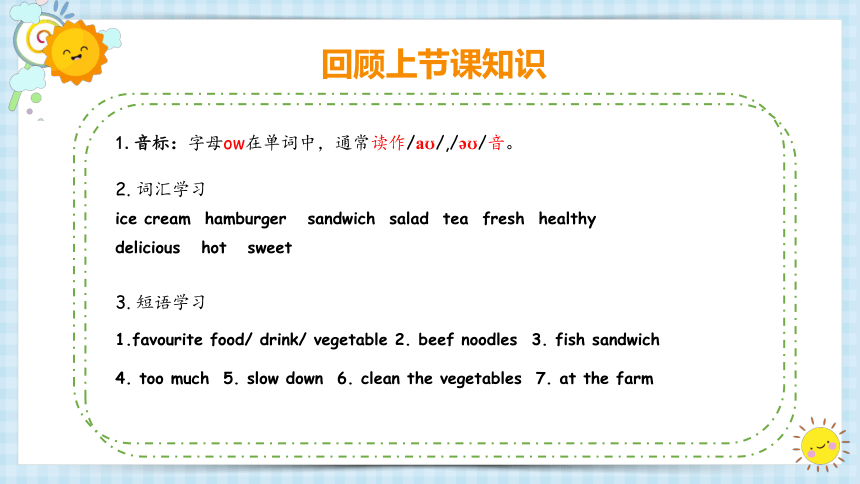
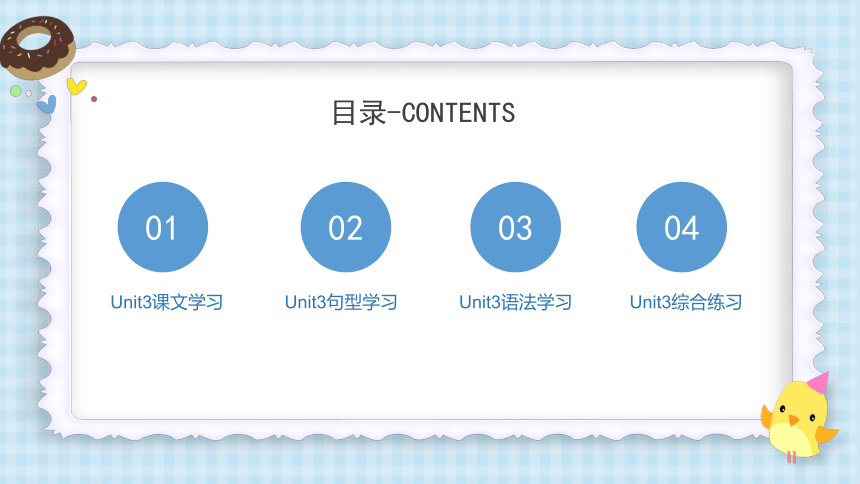

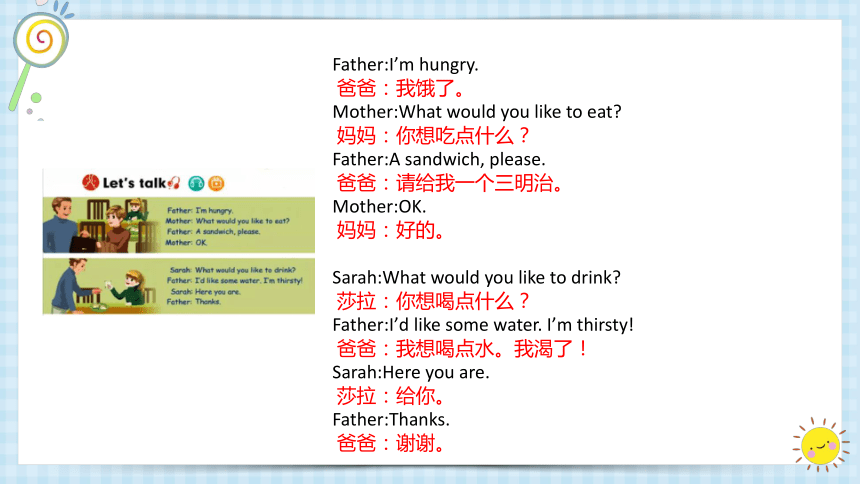
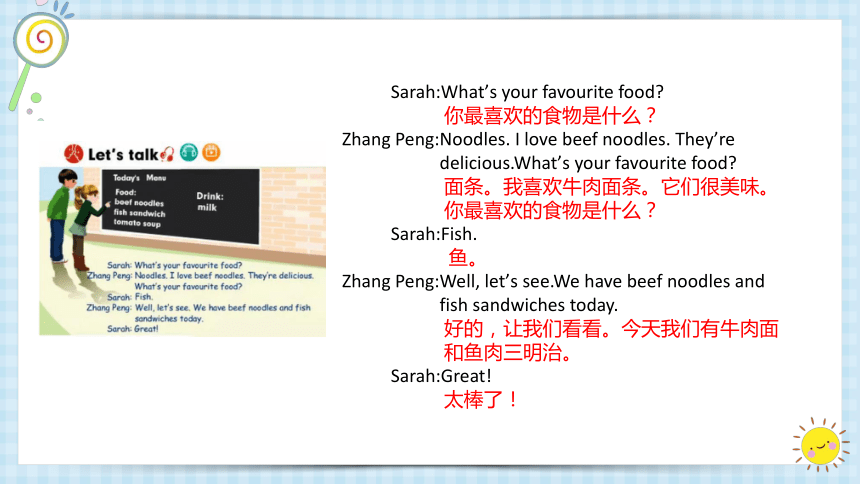

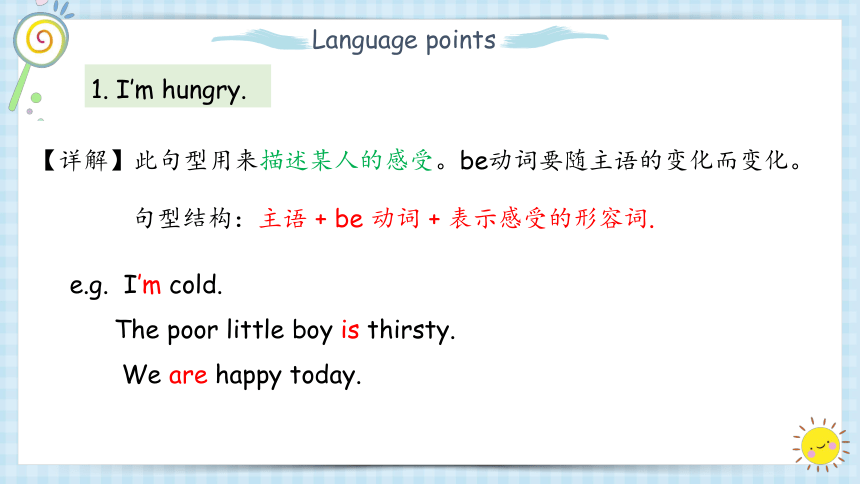
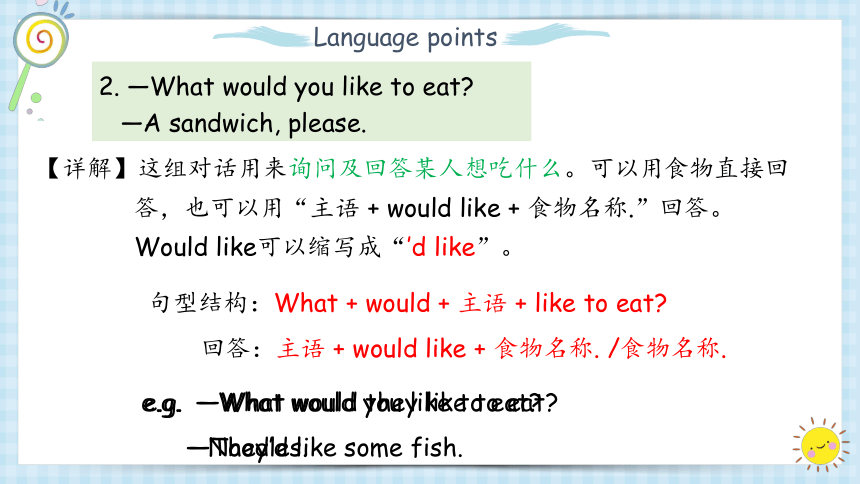
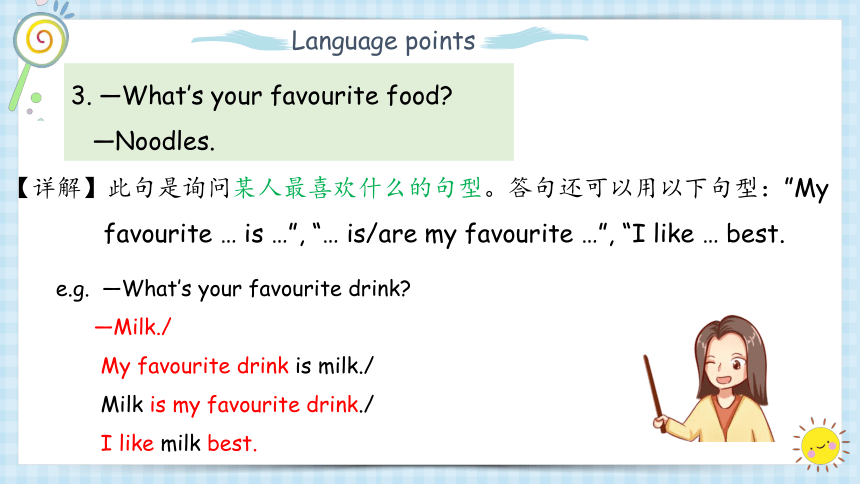
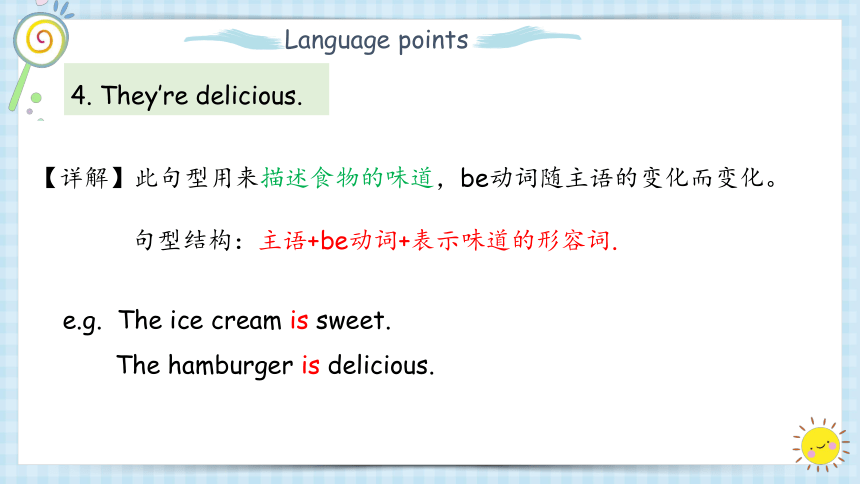
文档简介
(共47张PPT)
人教版五年级上册单元复习自学课件
Unit 3
What would you like?
Unit3 What would you like?
课文 句型 语法
回顾上节课知识
1.音标:字母ow在单词中,通常读作/a /,/ /音。
2. 词汇学习
ice cream hamburger sandwich salad tea fresh healthy
delicious hot sweet
3. 短语学习
1.favourite food/ drink/ vegetable 2. beef noodles 3. fish sandwich
4. too much 5. slow down 6. clean the vegetables 7. at the farm
目录-CONTENTS
Unit3句型学习
02
Unit3语法学习
03
Unit3综合练习
04
01
Unit3课文学习
01
Unit3 课文学习
01
Father:I’m hungry.
爸爸:我饿了。
Mother:What would you like to eat
妈妈:你想吃点什么?
Father:A sandwich, please.
爸爸:请给我一个三明治。
Mother:OK.
妈妈:好的。
Sarah:What would you like to drink
莎拉:你想喝点什么?
Father:I’d like some water. I’m thirsty!
爸爸:我想喝点水。我渴了!
Sarah:Here you are.
莎拉:给你。
Father:Thanks.
爸爸:谢谢。
Sarah:What’s your favourite food
你最喜欢的食物是什么?
Zhang Peng:Noodles. I love beef noodles. They’re
delicious.What’s your favourite food
面条。我喜欢牛肉面条。它们很美味。
你最喜欢的食物是什么?
Sarah:Fish.
鱼。
Zhang Peng:Well, let’s see.We have beef noodles and
fish sandwiches today.
好的,让我们看看。今天我们有牛肉面
和鱼肉三明治。
Sarah:Great!
太棒了!
Unit3 句型学习
02
1. I’m hungry.
【详解】此句型用来描述某人的感受。be动词要随主语的变化而变化。
句型结构:主语 + be 动词 + 表示感受的形容词.
e.g. I’m cold.
The poor little boy is thirsty.
We are happy today.
Language points
Language points
2. —What would you like to eat
—A sandwich, please.
【详解】这组对话用来询问及回答某人想吃什么。可以用食物直接回
答,也可以用“主语 + would like + 食物名称.”回答。
Would like可以缩写成“’d like”。
句型结构:What + would + 主语 + like to eat
回答:主语 + would like + 食物名称. /食物名称.
e.g. —What would you like to eat
—Noodles.
e.g. —What would they like to eat
—They’d like some fish.
Language points
3. —What’s your favourite food
—Noodles.
【详解】此句是询问某人最喜欢什么的句型。答句还可以用以下句型:”My
favourite … is …”, “… is/are my favourite …”, “I like … best.
e.g. —What’s your favourite drink
—Milk./
My favourite drink is milk./
Milk is my favourite drink./
I like milk best.
4. They’re delicious.
【详解】此句型用来描述食物的味道,be动词随主语的变化而变化。
句型结构:主语+be动词+表示味道的形容词.
e.g. The ice cream is sweet.
The hamburger is delicious.
Language points
一、单项选择。
( ) 1. What ____ you like to drink
A. are B. do C. would
( ) 2. I’d like to drink some _____.
A. apples B. water C. waters
( ) 3. I ____ like to eat some eggs.
A. will B. would C. do
C
B
B
Exercises
二、连词成句。
1. like, soup, she, would, some (.)
____________________________________________
2. to, drink, what, you, like, would ( )
____________________________________________
3. Mum, are, and, I, thirsty (.)
____________________________________________
She would like some soup.
What would you like to drink
Mum and I are thirsty.
Exercises
三、仿照例子写句子。
例: grapes/fresh
—What’s your favourite fruit
—Grapes. They’re fresh.
Exercises
1. peppers/hot
—____________________________________
—Peppers. They’re hot.
What is your favourite food
Exercises
Exercises
2. hamburgers/delicious
—____________________________________
—____________________________________
What is your favourite food
Hamburgers. They're delicious.
Exercises
3. ice cream/sweet
—____________________________________
—____________________________________
What is your favourite food
Ice cream. It’s sweet.
Exercises
4. salad/healthy
—____________________________________
—____________________________________
What is your favourite food
Salad. It’s healthy.
Exercises
Unit3 语法学习
03
名词单数变复数的基本规则
1. 绝大多数可数名词的复数形式,是在该词末尾加上 s。
结尾是清辅音读/s/,结尾是浊辅音或元音读/z/。
如:
carrot→ carrots
onion → onions;
banana → bananas
语法
/s/
/z/
/z/
名词单数变复数的基本规则
2. 凡是以s、x、ch、sh结尾的词,以及有生命的,以o结尾的词,在该词末尾加上 es构成复数。
读音变化:统一读/ z/。
如:box → boxes;dish → dishes;
注意:
zoo(动物园),photo(照片),piano(钢琴),
这三个词的复数形式是在词尾加 s。(无生命)
语法
语法
名词单数变复数的基本规则
3.以辅音字母+y结尾的名词,将y变为i,再加-es。
读音变化: -ies读/ z/。
如:
candy → candies;
story → stories
语法
以元音字母+y结尾的名词,直接加-s。
如:toy→ toys
名词单数变复数的基本规则
4.以f或fe结尾的名词,多将f或fe改变为-ves。
读音变化:尾音/f/改读/vz/
如:knife → knives;
life → lives; leaf → leaves
语法
可数名词变复数一般规则:
1.一般情况加-s,如 book /books; desk / desks等。
2.以s, x, ch, sh 等结尾的名词, 通常加-es:bus /buses
3.以y 结尾的名词,分两种情况:以“辅音字母+y”结尾的,将 y改为 i+es;以“元音字母+y”结尾的名词,直接加-s:city/ cities, toy/ toys 等。
4.以f或fe结尾的名词,多将f或fe改变为-ves。
5.以o结尾的名词,有生命的加 es,无生命的加s:
tomato /tomatoes; photo/photos
总结
典例
( ) 1. I’d like to eat some ________.
A. pencils B. water C. tomatoes
C
点拨:
要注意掌握tomato的复数是在词尾加 -es。故选C。
Exercises
把下列名词变为复数:
1. pear 2. potato
3. bus 4. box
5. strawberry 6. zoo
pears
potatoes
buses
boxes
strawberries
zoos
Exercises
一、单复数转换。
bus → _________
book → _________
sandwich → _________
_________ → dresses
hot dog → _________
_________→ potatoes
buses
books
sandwiches
dress
hot dogs
potato
Exercises
二、将图片和对应的单词连起来。
sandwich
salad
hot
sweet
tea
onion
Exercises
三、单项选择。
1. I don’t like apples ________ bananas are OK.
A. but B. and C. or
2. I like vegetables ________ I don’t like carrots.
A. but B. and C. or
A
A
点拨:
当前后两个句子句意转折时,要用连词but,故选A。
Exercises
3. My favourite vegetable is ________.
A. potato B. potatoes C. beef
4. I’d like some ________, please.
A. sandwich B. the sandwich C. sandwiches
B
C
Exercises
Unit3综合练习
04
1. a hamburger two _______________
2. noodle some ______________
3. a sandwich four_______________
4. one box many ______________
5. one tomato three ______________
6. an onion five _______________
7. a strawberry some ______________
hamburgers
noodles
sandwiches
boxes
tomatoes
onions
strawberries
Exercises
一、写出下列单词的复数形式。
二、根据首字母及汉语提示完成单词,补全句子。
1. I love hamburgers.
They’re d________(美味的).
2. She loves ice cream.
It’s s________(甜的).
elicious
weet
Exercises
3. My favourite food is salad.
It’s h________(健康的).
4. I love vegetables.
They’re f________(新鲜的).
5. I don’t like chillies .
They are h________(辣的).
ealthy
resh
ot
Exercises
三、单项选择。
( )1. What’s________ favourite food
A. you B. your C. yours
( )2. I like________.
A. beefs noodle B. beef noodles
C. beefs noodles
B
B
Exercises
( )3. We have________ today.
A. beef sandwich B. beef sandwichs
C. beef sandwiches
( )4. ________ favourite food is fish .
A. She B. Her C. You
( )5. Sarah’s favourite ________ is milk .
A. fruit B. drink C. vegetable
C
B
B
Exercises
四、按要求完成句子。
1. I’d like some orange juice .
(改为一般疑问句, 并回答)
—________ you________ ________ orange juice
—Yes, ________.
Would like some please
Exercises
2. My favourite food is noodles. (对画线部分提问)
________ ________ ____________ food
3. fish have sandwiches we today(. )
(连词成句)
__________________________________________
What’s your favourite
We have fish sandwiches today.
Exercises
五、句型转换。
1. I like ice cream. (改为否定句)
2. Do you like fish (否定回答)
3. My favourite food is mutton. (对画线部分提问)
I don’t like ice cream.
No, I don’t.
What’s your favourite food
Exercises
六、连词成句。
1. you drink what to like would(?)
_________________________________________
2. are you here(. )
_________________________________________
What would you like to drink
Here you are.
Exercises
3. eat to like what you would(?)
_______________________________________
4. some eggs like I’d(. )
_______________________________________
5. like Sarah some would bread(. )
_______________________________________
What would you like to eat
I’d like some eggs.
Sarah would like some bread.
Exercises
七、根据情景对话, 选择合适的句子填空。
Mary: Hi, John. 1. ________
John: Noodles. 2. ________
They are delicious.
Mary: What’s your favourite drink
D
A
A. I like beef noodles best.
B. We have beef noodles, chicken and rice today.
C. Do you like milk
D. What’s your favourite food
E. I like milk best.
John: 3. ________ It’s healthy.
4. ________
Mary: Yes, I do.
ohn: What’s your favourite food
Mary: I like chicken and rice best.
John: OK. 5. ________
Mary: Great!
E
C
A. I like beef noodles best.
B. We have beef noodles, chicken and rice today.
C. Do you like milk
D. What’s your favourite food
E. I like milk best.
B
Exercises
Thank You
谢谢
21世纪教育网(www.21cnjy.com)
中小学教育资源网站
兼职招聘:
https://www.21cnjy.com/recruitment/home/admin
人教版五年级上册单元复习自学课件
Unit 3
What would you like?
Unit3 What would you like?
课文 句型 语法
回顾上节课知识
1.音标:字母ow在单词中,通常读作/a /,/ /音。
2. 词汇学习
ice cream hamburger sandwich salad tea fresh healthy
delicious hot sweet
3. 短语学习
1.favourite food/ drink/ vegetable 2. beef noodles 3. fish sandwich
4. too much 5. slow down 6. clean the vegetables 7. at the farm
目录-CONTENTS
Unit3句型学习
02
Unit3语法学习
03
Unit3综合练习
04
01
Unit3课文学习
01
Unit3 课文学习
01
Father:I’m hungry.
爸爸:我饿了。
Mother:What would you like to eat
妈妈:你想吃点什么?
Father:A sandwich, please.
爸爸:请给我一个三明治。
Mother:OK.
妈妈:好的。
Sarah:What would you like to drink
莎拉:你想喝点什么?
Father:I’d like some water. I’m thirsty!
爸爸:我想喝点水。我渴了!
Sarah:Here you are.
莎拉:给你。
Father:Thanks.
爸爸:谢谢。
Sarah:What’s your favourite food
你最喜欢的食物是什么?
Zhang Peng:Noodles. I love beef noodles. They’re
delicious.What’s your favourite food
面条。我喜欢牛肉面条。它们很美味。
你最喜欢的食物是什么?
Sarah:Fish.
鱼。
Zhang Peng:Well, let’s see.We have beef noodles and
fish sandwiches today.
好的,让我们看看。今天我们有牛肉面
和鱼肉三明治。
Sarah:Great!
太棒了!
Unit3 句型学习
02
1. I’m hungry.
【详解】此句型用来描述某人的感受。be动词要随主语的变化而变化。
句型结构:主语 + be 动词 + 表示感受的形容词.
e.g. I’m cold.
The poor little boy is thirsty.
We are happy today.
Language points
Language points
2. —What would you like to eat
—A sandwich, please.
【详解】这组对话用来询问及回答某人想吃什么。可以用食物直接回
答,也可以用“主语 + would like + 食物名称.”回答。
Would like可以缩写成“’d like”。
句型结构:What + would + 主语 + like to eat
回答:主语 + would like + 食物名称. /食物名称.
e.g. —What would you like to eat
—Noodles.
e.g. —What would they like to eat
—They’d like some fish.
Language points
3. —What’s your favourite food
—Noodles.
【详解】此句是询问某人最喜欢什么的句型。答句还可以用以下句型:”My
favourite … is …”, “… is/are my favourite …”, “I like … best.
e.g. —What’s your favourite drink
—Milk./
My favourite drink is milk./
Milk is my favourite drink./
I like milk best.
4. They’re delicious.
【详解】此句型用来描述食物的味道,be动词随主语的变化而变化。
句型结构:主语+be动词+表示味道的形容词.
e.g. The ice cream is sweet.
The hamburger is delicious.
Language points
一、单项选择。
( ) 1. What ____ you like to drink
A. are B. do C. would
( ) 2. I’d like to drink some _____.
A. apples B. water C. waters
( ) 3. I ____ like to eat some eggs.
A. will B. would C. do
C
B
B
Exercises
二、连词成句。
1. like, soup, she, would, some (.)
____________________________________________
2. to, drink, what, you, like, would ( )
____________________________________________
3. Mum, are, and, I, thirsty (.)
____________________________________________
She would like some soup.
What would you like to drink
Mum and I are thirsty.
Exercises
三、仿照例子写句子。
例: grapes/fresh
—What’s your favourite fruit
—Grapes. They’re fresh.
Exercises
1. peppers/hot
—____________________________________
—Peppers. They’re hot.
What is your favourite food
Exercises
Exercises
2. hamburgers/delicious
—____________________________________
—____________________________________
What is your favourite food
Hamburgers. They're delicious.
Exercises
3. ice cream/sweet
—____________________________________
—____________________________________
What is your favourite food
Ice cream. It’s sweet.
Exercises
4. salad/healthy
—____________________________________
—____________________________________
What is your favourite food
Salad. It’s healthy.
Exercises
Unit3 语法学习
03
名词单数变复数的基本规则
1. 绝大多数可数名词的复数形式,是在该词末尾加上 s。
结尾是清辅音读/s/,结尾是浊辅音或元音读/z/。
如:
carrot→ carrots
onion → onions;
banana → bananas
语法
/s/
/z/
/z/
名词单数变复数的基本规则
2. 凡是以s、x、ch、sh结尾的词,以及有生命的,以o结尾的词,在该词末尾加上 es构成复数。
读音变化:统一读/ z/。
如:box → boxes;dish → dishes;
注意:
zoo(动物园),photo(照片),piano(钢琴),
这三个词的复数形式是在词尾加 s。(无生命)
语法
语法
名词单数变复数的基本规则
3.以辅音字母+y结尾的名词,将y变为i,再加-es。
读音变化: -ies读/ z/。
如:
candy → candies;
story → stories
语法
以元音字母+y结尾的名词,直接加-s。
如:toy→ toys
名词单数变复数的基本规则
4.以f或fe结尾的名词,多将f或fe改变为-ves。
读音变化:尾音/f/改读/vz/
如:knife → knives;
life → lives; leaf → leaves
语法
可数名词变复数一般规则:
1.一般情况加-s,如 book /books; desk / desks等。
2.以s, x, ch, sh 等结尾的名词, 通常加-es:bus /buses
3.以y 结尾的名词,分两种情况:以“辅音字母+y”结尾的,将 y改为 i+es;以“元音字母+y”结尾的名词,直接加-s:city/ cities, toy/ toys 等。
4.以f或fe结尾的名词,多将f或fe改变为-ves。
5.以o结尾的名词,有生命的加 es,无生命的加s:
tomato /tomatoes; photo/photos
总结
典例
( ) 1. I’d like to eat some ________.
A. pencils B. water C. tomatoes
C
点拨:
要注意掌握tomato的复数是在词尾加 -es。故选C。
Exercises
把下列名词变为复数:
1. pear 2. potato
3. bus 4. box
5. strawberry 6. zoo
pears
potatoes
buses
boxes
strawberries
zoos
Exercises
一、单复数转换。
bus → _________
book → _________
sandwich → _________
_________ → dresses
hot dog → _________
_________→ potatoes
buses
books
sandwiches
dress
hot dogs
potato
Exercises
二、将图片和对应的单词连起来。
sandwich
salad
hot
sweet
tea
onion
Exercises
三、单项选择。
1. I don’t like apples ________ bananas are OK.
A. but B. and C. or
2. I like vegetables ________ I don’t like carrots.
A. but B. and C. or
A
A
点拨:
当前后两个句子句意转折时,要用连词but,故选A。
Exercises
3. My favourite vegetable is ________.
A. potato B. potatoes C. beef
4. I’d like some ________, please.
A. sandwich B. the sandwich C. sandwiches
B
C
Exercises
Unit3综合练习
04
1. a hamburger two _______________
2. noodle some ______________
3. a sandwich four_______________
4. one box many ______________
5. one tomato three ______________
6. an onion five _______________
7. a strawberry some ______________
hamburgers
noodles
sandwiches
boxes
tomatoes
onions
strawberries
Exercises
一、写出下列单词的复数形式。
二、根据首字母及汉语提示完成单词,补全句子。
1. I love hamburgers.
They’re d________(美味的).
2. She loves ice cream.
It’s s________(甜的).
elicious
weet
Exercises
3. My favourite food is salad.
It’s h________(健康的).
4. I love vegetables.
They’re f________(新鲜的).
5. I don’t like chillies .
They are h________(辣的).
ealthy
resh
ot
Exercises
三、单项选择。
( )1. What’s________ favourite food
A. you B. your C. yours
( )2. I like________.
A. beefs noodle B. beef noodles
C. beefs noodles
B
B
Exercises
( )3. We have________ today.
A. beef sandwich B. beef sandwichs
C. beef sandwiches
( )4. ________ favourite food is fish .
A. She B. Her C. You
( )5. Sarah’s favourite ________ is milk .
A. fruit B. drink C. vegetable
C
B
B
Exercises
四、按要求完成句子。
1. I’d like some orange juice .
(改为一般疑问句, 并回答)
—________ you________ ________ orange juice
—Yes, ________.
Would like some please
Exercises
2. My favourite food is noodles. (对画线部分提问)
________ ________ ____________ food
3. fish have sandwiches we today(. )
(连词成句)
__________________________________________
What’s your favourite
We have fish sandwiches today.
Exercises
五、句型转换。
1. I like ice cream. (改为否定句)
2. Do you like fish (否定回答)
3. My favourite food is mutton. (对画线部分提问)
I don’t like ice cream.
No, I don’t.
What’s your favourite food
Exercises
六、连词成句。
1. you drink what to like would(?)
_________________________________________
2. are you here(. )
_________________________________________
What would you like to drink
Here you are.
Exercises
3. eat to like what you would(?)
_______________________________________
4. some eggs like I’d(. )
_______________________________________
5. like Sarah some would bread(. )
_______________________________________
What would you like to eat
I’d like some eggs.
Sarah would like some bread.
Exercises
七、根据情景对话, 选择合适的句子填空。
Mary: Hi, John. 1. ________
John: Noodles. 2. ________
They are delicious.
Mary: What’s your favourite drink
D
A
A. I like beef noodles best.
B. We have beef noodles, chicken and rice today.
C. Do you like milk
D. What’s your favourite food
E. I like milk best.
John: 3. ________ It’s healthy.
4. ________
Mary: Yes, I do.
ohn: What’s your favourite food
Mary: I like chicken and rice best.
John: OK. 5. ________
Mary: Great!
E
C
A. I like beef noodles best.
B. We have beef noodles, chicken and rice today.
C. Do you like milk
D. What’s your favourite food
E. I like milk best.
B
Exercises
Thank You
谢谢
21世纪教育网(www.21cnjy.com)
中小学教育资源网站
兼职招聘:
https://www.21cnjy.com/recruitment/home/admin
